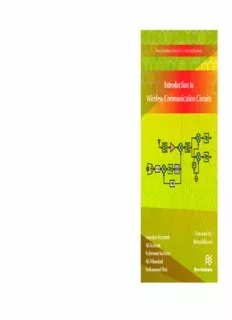
Introduction to Wireless Communication Circuits PDF
Preview Introduction to Wireless Communication Circuits
Introduction to W River Publishers Series in Circuits and Systems i r e Wireless Communication Circuits l e s s CI n o Forouhar Farzaneh, Ali Fotowat, Mahmoud Kamarei, mtr o md Introduction to Ali Nikoofard and Mohammad Elmi uu nc t icio Wireless Communication Circuits Over the past decade, tremendous development of Wireless an t Communications has changed human life and engineering. io t o n Considerable advancement has been made in design and C architecture of related RF and microwave circuits. Introduction i r to Wireless Communication Circuits focusses on special circuits c u dedicated to the RF level of wireless communications. From i t s oscillators to modulation and demodulation, and from mixers to RF and power amplifier circuits, all are presented in a sequential manner. A wealth of analytical relations is provided in the text F o alongside various worked out examples. Related problem sets r o are given at the end of each chapter. Basic concepts of RF Analog u h Circuit Design are developed in the book. a Ar lF Technical topics discussed include: i Nar /2 • Wireless Communication System ikza ÷N VCO on • RF Oscillators and Phase Locked Loops oe h f a, • Modulator and Demodulator Circuits rd A ÷M • RF Mixers ali nF • Automatic Gain Control and Limiters do t o • Microwave Circuits, Transmission Lines and S-Parameters M w • Matching networks oa ht • Linear Amplifier Design and Power Amplifiers am, M • Linearization Techniques ma h am d This textbook is intended for advanced undergraduate and o Eu graduate students, as well as RF Engineers and professionals. lmd iK Foreword by: a Forouhar Farzaneh m a Behzad Razavi r Ali Fotowat e i , Mahmoud Kamarei Ali Nikoofard River Publishers Mohammad Elmi River Publishers River Introduction to Wireless Communication Circuits F. Farzaneh, A. Fotowat, M. Kamarei A. Nikoofard and M. Elmi RIVER PUBLISHERS SERIES IN CIRCUITS AND SYSTEMS SeriesEditors MASSIMOALIOTO KOFIMAKINWA NationalUniversityofSingapore DelftUniversityofTechnology Singapore TheNetherlands DENNISSYLVESTER UniversityofMichigan USA Indexing: AllbookspublishedinthisseriesaresubmittedtoThomsonReutersBook CitationIndex(BkCI),CrossRefandtoGoogleScholar. The “River Publishers Series in Circuits & Systems” is a series of comprehensive academicandprofessionalbookswhichfocusontheoryandapplicationsofCircuit and Systems. This includes analog and digital integrated circuits, memory tech- nologies, system-on-chip and processor design. The series also includes books on electronic design automation and design methodology, as well as computer aided designtools. Books published in the series include research monographs, edited volumes, handbooksandtextbooks. Thebooksprovideprofessionals,researchers,educators, andadvancedstudentsinthefieldwithaninvaluableinsightintothelatestresearch anddevelopments. Topicscoveredintheseriesinclude,butarebynomeansrestrictedtothefollowing: • AnalogIntegratedCircuits • DigitalIntegratedCircuits • DataConverters • ProcessorArchitecures • System-on-Chip • MemoryDesign • ElectronicDesignAutomation Foralistofotherbooksinthisseries,visitwww.riverpublishers.com Introduction to Wireless Communication Circuits ForouharFarzaneh Professor SharifUniversityofTechnology,Iran AliFotowat AssociateProfessor SharifUniversityofTechnology,Iran MahmoudKamarei Professor UniversityofTehran,Iran AliNikoofard ResearchEngineer UniversityofCaliforniaatSanDiego,USA MohammadElmi ResearchEngineer KavoshComAsiaCo.,Iran River Publishers Published,soldanddistributedby: RiverPublishers Alsbjergvej10 9260Gistrup Denmark RiverPublishers LangeGeer44 2611PWDelft TheNetherlands Tel.: +45369953197 www.riverpublishers.com ISBN:978-87-93609-71-6(Hardback) 978-87-93609-70-9(Ebook) (cid:13)c2018RiverPublishers Allrightsreserved. Nopartofthispublicationmaybereproduced,storedina retrievalsystem,ortransmittedinanyformorbyanymeans,mechanical, photocopying,recordingorotherwise,withoutpriorwrittenpermissionofthe publishers. Foreword As wireless technology takes over every aspect of our lives, the university curriculamustkeepupwiththedevelopmentsandimpartproperskillstotheir graduatessoastopreparethemforthisrapidly-evolvingindustry. Inparticular, the vast body of undergraduate students must be trained in this domain, but efficiently,ascourseproliferationisundesirableinmostuniversities. “IntroductiontoWirelessCommunicationCircuits”addressesthisneedby selectingthemostrelevanttopicsandteachingtheminalanguagethatappeals toundergraduatestudents. Thetextbookmethodicallyguidesthereaderthrough theconceptsand,usingnumerousdetailedexamples,reenforcestheseconcepts. Thereaderistheninvitedtoexercisehis/herunderstandingbysolvingproblems attheendofeachchapter. Thecontentsofthebookhavebeenchosencarefullytoallowcoveragein one semester or quarter. That is, the book can serve as a self-contained text thatthestudentscanread“covertocover”inonetermwithoutskippingany majorsections. Thesepedagogicalaspectsofthebookfacilitateitsuseforboth studentsandinstructors. BehzadRazavi Professor UniversityofCalifornia,LosAngeles February2018 v Preface Thetremendousdevelopmentofthewirelesscommunicationsduringthepast twenty years has had such a great impact on the human life and the society that no one can ignore its overwhelming presence in today’s life, let alone the today’s engineering. Students in Electrical Engineering, nowadays, are normally exposed to courses in wireless communications, wireless circuits, and the electromagnetic-wave propagation. The authors have been involved inteachingandresearchinthefieldofwirelesscircuitsduringthepastthirty years in the Iranian universities and institutions, namely, Sharif University ofTechnology, UniversityofTehran,andKavoshComAsiaR&DCompany. Duringtheseyears,wehavefeltalackofacomprehensivebookwhichwould covertheneededmaterialforacoursecoverageattheB.Sc. levelofElectrical Engineering. Furthermore,asengineersataresearchinstitution,weobserved thenecessityofacomprehensivetextwhichwouldhelptheRFengineersin theirRFcircuitdesignandimplementation. Asamatteroffact,anumberof circuitsandideaspresentedinthisbookwereobtainedduringthedevelopment ofnewRFtransceivercircuits,andwirelesscommunicationsystemsintended forfleetcontrolingroundtransportationatKavoshComCo. Wehavetestedorverifiedthemostofthepresentedcircuitsinthisbook by standard RF simulation tools to be sure of their proper operation. For materializingthisbook,wehaveusedmostofourcoursematerialsespecially intendedforthecommunicationcircuitscourse. Ittookusalongthreeyearsof intensiveworktorealizethisbook. Ourintentionwastomakeitaccessibleto theElectricalEngineeringcommunityworldwide,asaresultofoureffortsin thefieldofRFcircuitsandwirelesscommunication. vii viii Preface This book is divided into three parts. In Part I, chapter 1 is dedicated to thewirelesscommunicationsystemsandthebuildingblocksofamodernradio transceiver. Chapter2describesthemajoroperationandconfigurationofthe RFoscillatorswherethemajortopologiesofthemodernelectronicoscillators are presented as well as the large-signal modeling and evaluation of these circuits. Part II of the book is dedicated to the major building circuit blocks of moderntransceivers. Chapter3presentsPLLs,differentPLLtopologies,FM modulatorsandFMdemodulators. Chapter4dealswiththeRFmixercircuits wheredifferenttypesofmixersfromtheswitchingcircuitstoanalogmultipliers are presented. The major concepts of nonlinearity in RF circuits, namely, the compression, the intermodulation products, and the intercept point are introduced in this chapter. Chapter 5 is dedicated to Amplitude and Phase Modulation. Thischapterbeginswithanalogamplitudemodulationtechniques and then goes through present-day multilevel amplitude and phase digital modulations. Chapter6describestheLimitersandtheAutomaticGainControl circuits. Offsetcompensationcircuitsarepresentedinthischapterfollowed by different Automatic Gain Control methods. The amplitude detectors and methodsforincreasingtheGainBandwidthofamplifiersarealsodescribedin thischapteraswell. PartIII ofthebookisdedicatedtoTransmissionLines,Microwavecircuit modeling,andMicrowaveAmplifiersusingScatteringParametersaswellas thePowerAmplifierdescription. Chapter7describesthefundamentalsofRF TransmissionLinesandImpedanceMatchingCircuits. Chapter8isintendedto theintroductionofScatteringParametersasamoderntoolforamplifiercircuit designinthemicrowaverange. Chapter9presentstheanalysisanddesignof microwaveamplifiersusingS-parameters. Theproblemofstabilityoftwo-ports usingS-parametersisstudiedindetail. Thesimultaneousconjugatematching ofanamplifierusingS-parametersispresentedalongsidethedesignofLow- NoiseAmplifiersusingnoiseparameters. Thedesignoftwo-stageamplifiers includingthenoiseandthegainparametersisdescribedatlast. Inchapter10, thePowerAmplifiersarepresented. Differentclassesofpoweramplifiers,their modeofoperation,theirefficiencies,andtheirpowercapabilitiesarestudiedin thischapter. Thelinearizationmethodsforthepoweramplifiersasamodern toolforthepresent-daytransmittersarepresentedinthischapteraswell. Wewouldliketothankallthecolleaguesandthestudentsfortheirhelpful discussionsandencouragementswhichwerenecessaryforthematerialization ofthisbook. F.Farzaneh,A.Fotowat,M.Kamarei,A.NikoofardandM.Elmi Tehran,Iran December2017 Contents Foreword........................................ v Preface ....................................... vii ListofFig.u.re.s................................... xvii ListofTab.l.e.s.................................. xxxv ListofAb.b.re.v.i.a.ti.o.n.s........................... xxxvii I Part 1 1 TheAmazingWorldofWirelessSystems ......... 3 1.1 IntroductiontoCommunicationCircuits. . . . . . . . . . . . . 3 1.2 SignalLevelsandRayleighFading . . . . . . . . . . . . . . . . 8 1.3 CalculationoftheSensitivityinDifferentStandards . . . . . 9 1.4 ConsiderationsinRadioFrequencySystemDesign . . . . 10 1.5 ABasicUnderstandingofFrequencySynthesizers . . . . . 17 1.6 Conclusion . . . . . . . . . . . . . . . . . . . . . . . . . . . . . . . . 21 1.7 ReferencesandFurtherReading . . . . . . . . . . . . . . . . . 21 1.8 Problems . . . . . . . . . . . . . . . . . . . . . . . . . . . . . . . . . 21 ix
Description: